Early on Tuesday morning, we had our first sightings of our destination - Sandakan. This was originally part of British North Borneo which is now called Sabah and is part of Malaysia. We passed the massive bulk of Pulau Berhala on our starboard side and entered the large natural harbour which allowed Sandakan to develop as an important port.
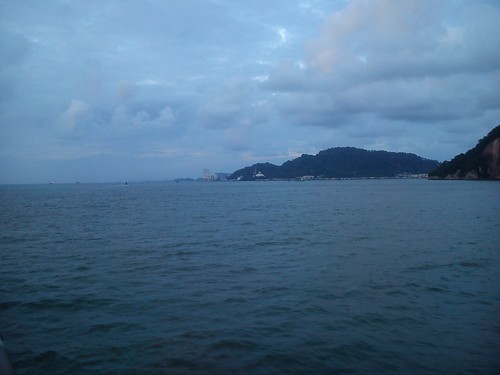 Approaching Sandakan, with a large mosque and beyond the multi-storey bulk of the 'Four Points by Sheraton' visible. Notice the number of ships dotted around the natural harbour.
Approaching Sandakan, with a large mosque and beyond the multi-storey bulk of the 'Four Points by Sheraton' visible. Notice the number of ships dotted around the natural harbour.
For the last time on this trip, I watched a Pilot climb aboard to assist the Captain in the final approach to our quay.

The Sandakan Pilot climbs aboard.
At about 7.00 a.m. Tuesday, we berthed alongside the quay, facing a rather bleak-looking transit shed. It appeared that our quay was more used to handling freight rather than people. A number of large, bulk material conveyor units stood ready for use at one end of the quay and a massive mobile harbour crane with a rubber-tyred chassis and outriggers stood at the other end of the quay. The crane was labelled 'Gottwald' but these cranes now seem to be marketed as Terex Gottwald Port Solutions. An adjacent quay appeared to deal with smaller passenger ferries which I think go to the Phillipines.
 'Caledonian Sky' gently approaches the quay at Sandakan.
'Caledonian Sky' gently approaches the quay at Sandakan.
An open lorry drew up next to the ship and the crew started to take our luggage ashore, setting it out next to the lorry. A group of musicians appeared and set up outside the transit shed, playing for seven dancers in traditional costume, watched by the passengers from various decks on the ship. A group of dock employees appeared and enjoyed the free entertainment.
 Traditional dancers welcome the ship.
Traditional dancers welcome the ship.
Saying our 'goodbyes' to the crew (many of whom were being relieved at Sandakan by fresh crew), the passengers disembarked for the last time, identified their luggage which was then loaded onto the lorry and boarded the three coaches which had appeared. We were to spend the day around Sandakan, before being reunited with our luggage (hopefully) at the 'Four Points by Sheraton' hotel. The coaches moved off through the dock area to join the main road to Sandakan town, about five miles away. The contrast with some of the rural places we'd visited was very striking. Everything is modern - the Japanese occupation during World War II and the subsequent Allied bombing reduced the town to rubble. Now, there are dual carriageways and frequent housing developments up to four stories tall. We didn't initially drive into the town centre but turned inland, eventually arriving at what was clearly a fairly 'upmarket' area of apartments with some detached houses. The coaches parked at the side of the road and we disembarked to enter the Sandakan Memorial Park. A dignified sign explained:-
"The Government of the State of Sabah has set aside this site as a memorial to those prisoners of war who suffered and died here, on the Death Marches and at Ranau. The memorial also commemorates the suffering and sacrifice of the local people."The wooded gardens were in immaculate condition and radiated a great sense of peace, in jarring contrast with how the area would have been during the Japanese occupation during World War II.
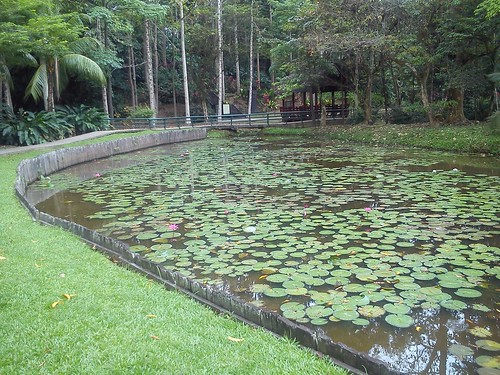 The immaculate gardens at Sandakan Memorial Park.
The immaculate gardens at Sandakan Memorial Park.
In 1942, 1500 Australian Prisoners of War were brought here to construct a military airfield for the Japanese. The following year, around 700 British and a further 500 Australian Prisoners of War arrived. Late in 1943, the prisoners were force-marched 260 km to Ranau in three 'Death Marches'. The only recorded survivors of these marches were six escapees. A Wikipedia article on this tragic era is here.
In the Sandakan Memorial Park, a wooden Commemorative Pavilion houses information displays and photographs. Nearby, there are a few reminders of the wartime camp - concrete water tanks, the remains of an ancient vertical boiler, an electric generator and a British 'Ruston Bucyrus' excavator. The excavator was commandeered by the Japanese but later sabotaged by an Australian prisoner. There is an engraved black marble monolith as the focus of the memorial park, and we were invited by our guide to observe a one minute silence here before three of the group placed wreathes.
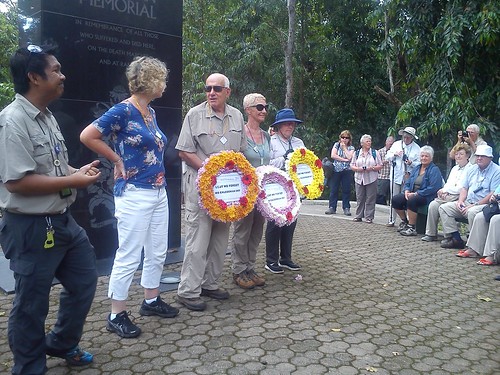 The Memorial Monolith.
The Memorial Monolith.
After this thought-provoking interlude, we returned to our coaches and continued our tour of modern Sandakan. Building is still proceeding - Sandakan is the second largest town in Sabah with a population of around 400,000. Only Kota Kinabulu (formerly called Jesselton) is larger. There are still fairly basic wooden houses on stilts but there is a policy to remove these, transferring the occupants to modern (if rather barrack-like) apartments.
 Modern apartments in Sandakan.
Modern apartments in Sandakan.
As we neared the centre of the town, we turned up into the hills overlooking the sea. Here we visited St. Michael's and All Angels Church, a granite building dating from the early twentieth century, next to the large St. Michael's school.
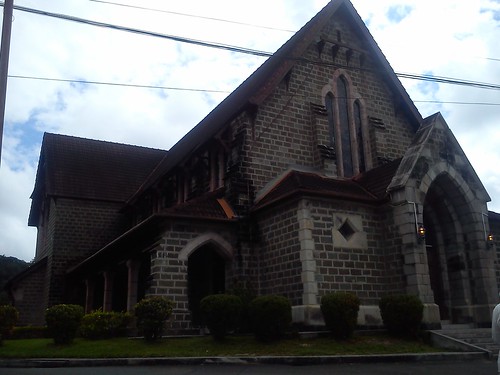 St. Michael's and All Angels Church.
St. Michael's and All Angels Church.
We re-joined our coaches for a short ride to the English Tea House and Restaurant which has the proper appearance of a colonial bungalow, with its own croquet lawn. Its hilltop location offers wonderful views of the natural harbour of Sandakan.
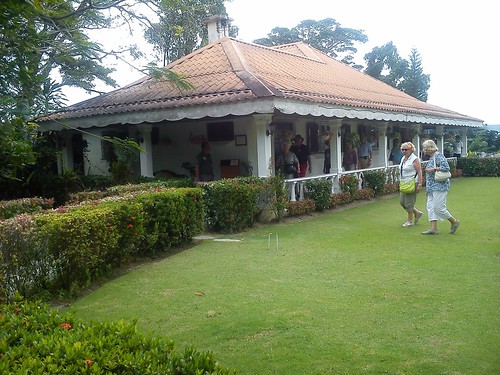 The English Tea House and Restaurant, Sandakan.
The English Tea House and Restaurant, Sandakan.
However, before we enjoyed luncheon at the English Tea House, we visited 'The Agnes Keith House' just next door. I'm afraid I'd not heard of Agnes Keith, but I was charmed by her house. Before World War II, she lived at the house with her husband who was Conservator of Forests and Director of Agriculture for the government of North Borneo. She wrote a book of her experiences called 'Land Below the Wind' which was prize-winning and has become a classic. During the War, the family were interned by the Japanese and that grim time is recounted in her book 'Three Came Home'. Upon release at the end of the War, they found that the house had been destroyed, but they rebuilt it on the same site and spent about five more years there, giving rise to another book 'White Man Returns', before moving first to the Phillipines and then Libya. The house in Sandakan became derelict before being restored by Sabah Museum and becoming an important visitor attraction.
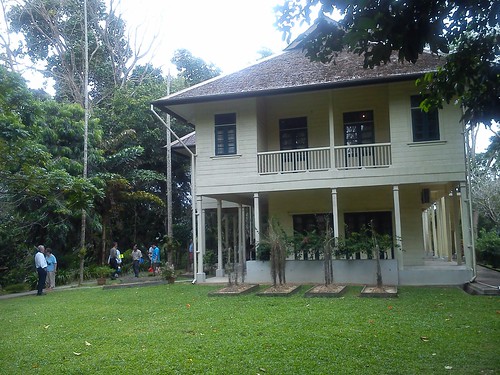 The restored Agnes Keith House.
The restored Agnes Keith House.
We then returned to the English Tea House for a very enjoyable buffet lunch. I was then drawn back to the Agnes Keith House for a final walk around the well-kept garden before boarding our waiting buses. Our next journey took us inland. After some of our recent visits to rather smaller communities, I was still having trouble getting used to the scale of developments around Sandakan - such as the aptly-named 'Giant' Hypermarket, part of the Malaysian 'Giant' chain.
 The 'Giant' Hypermarket, Sandakan.
The 'Giant' Hypermarket, Sandakan.
We were heading broadly west on Malaysia Federal Route 22. Around 14 miles from Sandakan, we left the main road to reach Sepilok, where we were to visit the Bornean Sun Bear Conservation Centre and Sepilok Orang Utan Rehabilitation Centre. I'll describe these visits in Part 22.
You can find all the posts on this trip here.
My pictures
Arriving at Sandakan, Sabah, Malaysia.
Sandakan, Sabah, Malaysia.
Sandakan Memorial Park, Sabah.
